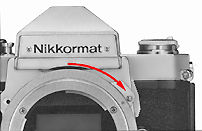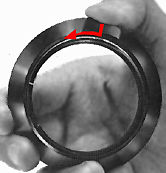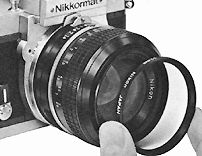INFRARED PHOTOGRAPHY
In infrared photography, the plane of sharpest focus is slightly more distant than
the one produced by visible light and seen by the naked eye through the viewfinder.
To compensate for the shift in focus, Nikkor lenses have a red dot or line on the
lens barrel near the color-coded depth-of-field index scale on top of the lens. After
focusing the image sharply through the viewfinder, turn the focusing ring to the
left until the red dot lines up with the prefocused distance.
 |
For example, in the picture below the 50mm f/1.4 lens has been focused at infinity (OO). The focusing ring is turned slightly to the left so that the infinity mark appears in line with the red dot. |
When lenses having a focal
length of 50mm or less are stopped down to f/8 or smaller, no adjustment is necessary:
at such small apertures and short focal lengths, lenses have enough depth of field
to compensate for the shift in focus.
SILVER-OXIDE BATTERY
Perhaps one of the most significant issue or improvement made on the FT2 when compared with earlier Nikkormat models are the use of the more environmental friendly silver oxide battery instead of the mercury cells as the power source.The Nikkormat FT2's meter circuit is powered by a single 1.5-volt silver-oxide -battery located in the battery chamber on the camera baseplate.
 |
When the battery is exhausted, the meter will cease to function all at once. To replace the battery, unscrew the cap over the battery chamber with a coin or similar object. When installing a new battery make sure that the polarity of the batteries (plus (+) side) faces out. |
Note: If the meter is exposed to bright light at below-freezing temperatures over a long period of time, it may malfunction or cease to operate until the temperature rises again. Therefore, be careful not to leave the meter on for more than three mmutes at a time in cold weather. I am living in a hot and sunny all year round tropical zone and has little experience and knowledge when it relates to operation of battery cells in extreme cold weather condition. Perhaps you can use the message board to present your valuable experiences to others.
Caution: Never throw discarded batteries into a fire. It might explode.
EXPOSURE MEASUREMENT: SPECIAL CASES
Stop-Down Exposure
Measurement
With the following lenses and accessories, full-aperture exposure measurement is
not possible, either because the lens has no auto-diaphragm or because the diaphragm
will not couple with the meter.
 |
Therefore, the stop-down method must be used. This means measuring exposure with the lens aperture diaphragm stopped down to the taking aperture. |
Push the camera's coupling
pin as far to the right as it will go and mount a lens or a lens-and-intermediate
unit to the camera in the same way as the Nikkor Auto lenses. Switch on the meter
in the usual way.
Bellows Focusing Attachments, Extension Rings and Focusing Unit: To determine
exposure, select the desired shutter speed and stop down the lens manually until
the needle centers.
Preset Lenses: Use the same procedure as above for lenses having preset diaphragms,
such as the PC-Nikkor 35mm f/2.8 or the 28mm PC-Nikkor.
Auto Lenses Without Coupling Prong: Some older Nikkor lenses like the Zoom-Nikkor
Auto 200-600mm f/9.5 or the newer manual focus Series E or the AF Nikkor lenses (Generally,
it is not advisable to use in conjunction with a non-AI body such as the FT-2) have
an auto diaphragm but no coupling prong. Use the depth-of-field preview button to
stop down the lens until the needle is centered.
Reflex-Nikkor Lenses: The Reflex-Nikkor
500mm f/8, 1000mm f/11 and 2000mm f/11 lenses have no aperture diaphragm. Adjust
the shutter speed until the needle is centered.
Note: Since focusing may be difficult
or impossible at small apertures due to image darkening on the screen and non of
the Nikkormat models are provided with an interchangeable focusing screen feature.
You can first open the lens to full aperture to focus. Then determine the correct
exposure by the stop-down method (Press the DOF button to stop the lens diaphragm
and meter).
Repro-Copying
For originals such as photographs which have tonal gradation, exposure is determined
in the usual way. In the case of originals having strong contrast and no gradation,
such as documents or line drawings, measure brightness of the white portion of the
original (if the original is predominantly black, a sheet of white paper may be substituted)
after decreasing film speed by four marks. Or increase exposure about 1-1/3 stops.
Slide Copying
For originals with continuous tone gradations, determine exposure in the usual way
by the stop-down method. To copy slides with letters or figures on transparent background,
decrease film speed four marks or increase exposure about 1-1/3 stops. In the case
of transparent figures or letters on a dark background, either increase film speed
five marks or decrease exposure about 1-2/3 stops.
Important: These are only approximate
Guidelines. Exact
exposure determination is extremely difficult, especially with a less forgiving exposure
latitude color reversal films (Slide). Therefore, it is advisable to make several
different exposures for each subject to be sure of getting one that is correct. However,
if you are working with negative films, chances of exposure error can be minimal.
ACCESSORIES
Lens Hoods
The use of a lens hood is recommended at all times to prevent extraneous light from striking the lens surface and causing flare or ghost, and as an added measure of protection against damage to the lens. Nikon lens hoods come in four types, depending on the lens: Screw-In, Snap-On, Slip-On and Built-In. They are calculated precisely for each focal-length Nikkor lens to provide maximum protection against stray light.
 |
To attach or remove the snap-on hood, first depress the spring latch - which is marked with an arrow - and slide it in the direction of the arrow. The hood will also fit directly over a screw-in filter, so both can be used on a lens at the same time. When not in use, some older Nikkor lenses designed with their snap-on hood which can be reversed for storage on the lens, and the lens and its hood can be stored together in the eveready case. |
Filters
Filter primary usage is to supplement weaknesses in the film type. Some are specially effect glass while some used it merely for protection. Nikon filters are made of optical glass, ground and polished so that both surfaces are optically flat and parallel but they are usually more expensive than third party filters. If your primary concern is to use the filter to protect your expensive optic, just buy a simple, cheap one that will do (Remove it while taking picture). If you can afford it, Nikon made filters are of good consideration.
 |
Nikon filters are available in both screw-in and series mounts, depending on the lens. |
Note: If you wish to leave a fflter
on the lens to protect it against accidental damage, the use of the L37, L37C or
a skylight filter is good enough.
If the lens is pointed toward the sun or toward a very bright light at night, it
is best to remove any filter, since light reflected from the filter surface may form
ghost images on the film.
Eyepiece Correction Lenses
![]()
The nine eyepiece correction lenses are designed to permit nearsighted or farsighted
users to view and focus without their glasses. Available in -2, - 3, - 4, -5, 0,
+0.5, +1, +2 and +3 diopters, each representing the combined dioptry of the lens
and the finder. Simply unscrew the finder eyepiece and then screw on the right correction
lens. Since I have very little knowledge on the application and selection, I cannot
give you more advice than here.
Finder Eyecup
 |
The soft rubber finder eyecup fits directly onto the finder eyepiece to prevent extraneous light from entering the viewfinder. |
CAMERA CARE
Good camera care is primarily common sense care. Treat your Nikkormat as you would any valuable precision instrument and it will last a lifetime. Although the Nikkormat is ruggedly constructed to withstand rough handling, it may be damaged by shock, heat, water or misuse. The following are some basic tips for keeping your camera in top condition.
Storage
Keep the camera in an eveready case or compartment case when not in use to protect it from dust. Avoid storing the camera in excessively hot, cold or damp places. Always attach a body cap when the camera body is stored separately. Do not leave film in the camera for a long period of time. Note: Since the FT-2 is a mechanical camera that works with springs, levers and ball bearings, try not to leave the shutter or self-timer cocked if the camera is to be stored overnight or longer.
Lens
Keep the lens surface free from fingerprints and dust as far as possible. Use ONLY lens tissue to remove dust, never use cloth or ordinary tissue. If smudges or fingerprints appear, clean them with lens tissue moistened sparingly with alcohol. Remember, even an approved lens cleaner can cause damage if it seeps into the lens mount.
Keep the camera away from water.
Avoid excessive moisture. When using the camera near water, guard against splashes, especially salt-water spray.
Never attempt to lubricate or oil any part of the camera yourself. Lubrication should be left to an authorized serviceman (Even if Nikon service centre doesn't take your camera anymore but outside service centre should be able to help). Prior to taking a holiday trip or being assigned an important photo job, test your camera by making a few trial exposures. Remember, it takes at least two or three weeks for processing the test film and making any needed repairs or adjustment. Follow this important precaution and you will have pictures to remember.
Enjoy using your FT-2...
| Previous | Next | Part
5/5
| Back
|
to Index Page of
Nikkormat FT-2
| Back |
to Main Index
Page of Nikkormats
"Nikomat" Picture Library
of Japanese local version
Outline
the
major
key features and differences
of various models
The
Camera Bodies
| FT | FS | FTn | EL | FT2 | ELW | FT3 | EL2
This
site is made out 15.5MB with 478 items
(Jpeg, Gif, PDF & HTML files) (Last Update: 25th May 1999)
| Main Reference
Map
|
HTML Format: FT | FS | FTn | EL | FT2 | ELW | FT3 | EL2 | AW-1 Motor Winder
PDF Format: FT
| FS | FTn | EL | FT2 | ELW | FT3 | EL2 | AW-1 Motor Winder
| Specifications |
FT
| FS | FTn | EL | FT2 | ELW | FT3 | EL2
History
& Background
of Nikkormat Cameras
"Nikomat" Picture Library
of Japanese local version
Outline
the
major
key features and differences
of various models
The
Camera Bodies
| FT | FS | FTn | EL | FT2 | ELW | FT3 | EL2
| Main Reference
Map
|
HTML Format: FT | FS | FTn | EL | FT2 | ELW | FT3 | EL2 | AW-1 Motor Winder
PDF Format: FT
| FS | FTn | EL | FT2 | ELW | FT3 | EL2 | AW-1 Motor Winder
| Specifications |
FT
| FS | FTn | EL | FT2 | ELW | FT3 | EL2
| Message
Board
| for your favourite Nikkormats
| Message Board |
for your Nikon Optics in a shared environment
| Message Board |
Specifically for Dispose or Looking for Nikon/Nikkor Photographic
Equipment
 |
The Eyes of Nikon:- |
Fisheye-Nikkor Lenses - Circular | Full Frame | Ultrawides Lenses - 13mm15mm18mm20mm | Wideangle Lenses - 24mm28mm35mm |
Standard Lenses - 45mm 50mm 58mm | Telephoto Lenses - 85mm105mm135mm180mm & 200mm |
Super-Telephoto Lenses - 300mm 400mm 500mm 600mm 800mm 1200mm |
Special Application lenses:
Micro-Nikkor Lenses - 50mm~55mm -60mm 85mm -105mm 200mm Micro-Zoom 70-180mm
Perspective Control (PC) - 28mm 35mm PC-Micro 85mm
Dedicated Lenses for Nikon F3AF: AF 80mm f/2.8 | AF 200mm f/3.5 EDIF
Depth of Field Control (DC): 105mm 135mm
Medical Nikkor: 120mm 200mm
Reflex-Nikkor Lenses - 500mm 1000mm 2000mm
Others: Noct Nikkor | OP-Nikkor | UV Nikkor 55mm 105mm | Focusing Units | Bellows-Nikkor 105mm 135mm
Nikon Series E Lenses: 28mm35mm50mm100mm135mm | E-Series Zoom lenses: 36~72mm75~150mm70~210mm
MF Zoom-Nikkor Lenses: 25~50mm | 28~45mm | 28~50mm | 28~85mm | 35~70mm | 36~72mm E | 35~85mm | 35~105mm | 35~135mm |
35~200mm | 43~86mm | 50~135mm | 50~300mm | 70~210mm E | 75~150mm E | 80~200mm | 85~250mm |
100~300mm | 180~600mm | 200~400mm | 200~600mm | 360~1200mm | 1200~1700mm
Tele-Converters: TC-1 | TC-2 | TC-200 | TC-201 | TC-300 | TC-301 | TC-14 | TC-14A | TC-14B | TC-14C | TC-14E | TC-16 | TC-16A | TC-20E
![]()
Nikon F
| Nikon F2 |
Nikon
F3
| Nikon F4 |
Nikon
F5
| Nikon F6 |
Nikkormat / Nikomat |
Nikon FM
| Nikon FE/ FA | Nikon EM/FG/FG20 | Nikon Digital SLRs | Nikon - Other models
MIR Supports for Photographic Community: Various Message Boards/Community
Forums
Nikon
F-series|
Nikon
F2-series|
Nikon
F3-series|
Nikon F4-series| Nikon
F5-series|Nikkormat/Nikomat-series
Nikon FM-series|Nikon
FE-series|Nikon
FA|Nikon
Digital
SLR
series|Various
Nikon
Models|Nikkor
Optic
-shared
Others:- Free Trade Zone - Photography| Free Trade Zone - Business Community |Free To Zouk - Photographic Community
Apple's Mac Public Community Message Board | Windows based PC &
Apple/Mac
Public Community Trade Exchange Centre
Recommended links to understand
more technical details related to the Nikkor F-mount and production Serial Number:
http://rick_oleson.tripod.com/index-153.html by: my friend, Rick Oleson
http://www.zi.ku.dk/personal/lhhansen/photo/fmount.htm by: Hansen, Lars Holst
http://www.mir.com.my/rb/photography/hardwares/nikonfmount/lens2.htm
http://www.photosynthesis.co.nz/nikon/serialno.html
About
this photographic
site.
Home - Photography
In Malaysia
![]()
Copyright
© 1998.
HIURA Shinsaku ® ; Nikomat ML, Japan,
in collaboration with leofoo ®. MIR Web Development Team.
* Credit: A
Great thanks to Mr Denis Pleic for his volunteering
effort to reedit content and and patching some grammatical mistakes found in this
section of the PIM site. Miss
Rissa (Marketing) & Edward
(Techical) of Shriro Malaysia, distributor of Nikon cameras in Malaysia, in providing
so many useful inputs to make this site possible. Mr Hong,
Ipoh for lending me his FT2 to take some of the images used in this site. This site
is created for his eldest son, Yuen who has picked up his father's hobby and
the FT-2. My friend, John Walls from Florida, US for his images of the FTn
body and the Zoom Nikkor
43-86mm.
[Left Brain][Right brain][Home-MIR] [Invention][Art & Design][Clubs]
[Portfolios][On assignments] [Trading room][Knowledge & Resources] [Free-trade-zone][Thoughts & opinions][Links]